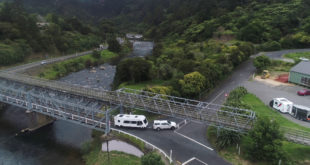Article by Thomas Pretty
 The production of motorhomes is currently experiencing an upturn in growth that will most likely increase in the coming years. The size and quality of motorhomes varies greatly, from the multi-million dollar models that are more akin to palaces than to mobile homes to the smaller tourers that provide a cost effective way to holiday. For the industry to carry on growing however certain changes will have to be introduced to maintain profitability; these changes are likely to affect workforces and methods of construction.
The production of motorhomes is currently experiencing an upturn in growth that will most likely increase in the coming years. The size and quality of motorhomes varies greatly, from the multi-million dollar models that are more akin to palaces than to mobile homes to the smaller tourers that provide a cost effective way to holiday. For the industry to carry on growing however certain changes will have to be introduced to maintain profitability; these changes are likely to affect workforces and methods of construction.
The first concern of industry players is to reduce the cost per man hour used in the construction of motorhomes. By doing this companies will be able to increase their profits by achieving the same number of sales while decreasing the production costs of each unit. Unfortunately for this to occur, it is likely that employment will suffer as customers pursue cheap prices.
Constructing motorhomes will also change. In the past motorhomes were constructed using a 'stick-build' method, today however this is rapidly being changed. The old method involves welding a frame from individual components and then bonding this to the chassis. This method is however extremely time consuming and expensive; understandably, more advanced methods are now being employed.
The industry today is adopting a system that uses pre-moulded sub-assemblies that fit directly onto the chassis subsequently reducing the man hours of construction and the cost per unit. While this method is not yet widespread, if the industry wants to continue to be profitable, it will have to adopt these methods wholesale.
Motorhomes were in the past constructed from aluminium and wood but this is changing rapidly. Modern plastics can perform just as well as these materials and hence have been extensively utilised. In addition, these plastic components are often pre-moulded and already contain all of the fixtures and fittings as well as insulation. The result is that these components can be bolted straight onto the chassis greatly reducing the time spent on construction; once again making the manufacture of motorhomes cheaper.
Another change that is likely to take place in the motorhomes industry is the power source used in the home. Diesel engines that are largely inefficient and expensive to run are being replaced by turbine engines as these are lighter and use less fuel for the same output. As with much of the motoring industry, solutions such as hybrid engines and hydrogen power are also being studied as a means of propulsion that do not use fossil fuels. Ultimately making motorhomes more eco-friendly is the primary goal.
Modern motorhomes are also utilising increasingly advanced waste management systems. In the past owners have always dreaded emptying the chemical toilet but this is changing with a modern trend for advanced, clean and effective systems. Leakage is an obvious problem with the hazardous chemicals used, so reducing this is an important objective.
Many of these changes, although being used by some manufacturing companies are not yet widespread across the industry. It is logical however that as these methods become more effective they will be increasingly used. With the demand for low prices ever growing and for the industry to carry on being prosperous, it must take these changes on board to maintain profitability.









Join the Discussion
Type out your comment here:
You must be logged in to post a comment.